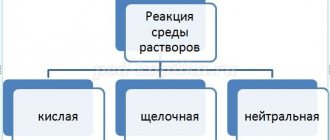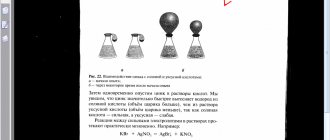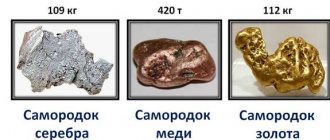Butuzova Taisiya Yurievna, chemistry teacher, MBOU "Sredneikoretskaya Secondary School" in the village of Sredniy Ikorets, Liskinsky district, Voronezh region. A lesson in discovering new knowledge in chemistry about alkali metal compounds for grade 9.
Lesson on discovering new knowledge in chemistry
for 9th graders on the topic: “Compounds of alkali metals”
(UMK : Chemistry. O.S. Gabrielyan)
Stages
lesson
| Teacher activities | Student activities | Planned results | |
| 1. Organizational moment. | Greets students and checks readiness for class | Greet the teacher and self-check readiness for the lesson | Personal UUD: formation of self-organization skills, emotional mood for the lesson |
| 2. Updating basic knowledge and skills (repetition of what has been covered) | Each pair of students completes a test task on the completed topic “Alkali metals” (Annex 1). The test takes 8 minutes. Upon completion, mutual control is carried out | Students perform the test task in pairs, carry out mutual control | Cognitive UUD: activation of previously existing knowledge; Communication UUD: developing the ability to evaluate the work of comrades |
| 3. Motivation to learn new material. | 1. Is it possible to find alkali metals in free form in nature? Why? 2. Guess in what form of compounds they can be found in nature? In nature, alkali metals are found only in the form of compounds. Na and K occur in nature in the form of chlorides, sulfates, silicates, etc. Li, Rb, Cs are found in various minerals. Fr is found in radioactive ores. 3. On the table there are objects containing alkali metal compounds (soda, salt, AA batteries, soap). Look at these objects. What do you think they have in common? 4. What haven’t we talked about yet? This will be the topic of our lesson. The topic of the lesson is “Sch.M connections.” | Students conclude that we will talk about Shch.M. compounds, their properties, and the use of Shch.M. compounds. Name the topic of the lesson and draw up a plan for studying it. Students conclude that we will talk about Shch.M. compounds, their properties, and the use of Shch.M. compounds. Name the topic of the lesson and draw up a plan for studying it. | Regulatory UUD: the ability to set a learning task and plan the stages of its solution. Cognitive UUD: development and deepening of the needs and motives of educational and cognitive activity; Personal UUD: formation of motivation for learning and purposeful cognitive activity. Communication UUD: formation of the ability to construct a speech utterance in accordance with the assigned tasks. |
| 4. Assimilation of new knowledge | The teacher divides the students into 3 groups. Each group is given a task that must be completed in 10 minutes and report to the class. (Appendix 2) Group 1 performs tasks to study the chemical properties of oxides of alkali metal using the example of potassium oxide 1. Write the equation for the reaction of sodium oxide with water. Na2O + H2O = 2NaOH The guys write down chemical reaction equations on the board and in their notebooks. 2. Write the equation for the reaction of sodium oxide with sulfuric acid Na2O + H2SO4 = Na2SO4 + H2O The guys write down chemical reaction equations on the board and in their notebooks. 3. Write the equation for the reaction of sodium oxide with carbon monoxide (IV) Na2O + CO2 = Na2CO3 Draw a conclusion about the chemical properties of alkali metal oxides. CONCLUSION: alkali metal oxides are capable of reacting with acids, acid oxides, and water | Students experimentally prove the chemical properties of Shch.M compounds. Draw conclusions based on experimental data | Cognitive UUD: formation of knowledge about the properties and application of alkali metal compounds; improving experimental skills of students. Regulatory UUD: the ability to solve a learning problem according to instructions; development of skills to select and analyze information obtained as a result of an experiment, working with a textbook Communication UUD: develop the ability to plan work in a group and logically present your conclusions. Personal UUD: develop the cognitive interest of schoolchildren using data on the application of the phenomena being studied in life around them. |
| 2nd group performs a task to study the chemical properties of sodium hydroxide. Purpose: to experimentally prove the chemical properties of alkali metal compounds using the example of sodium hydroxide. Instructions 1.Pour sodium hydroxide into a clean test tube and add a few drops of phenolphthalein. What are you observing? What solution environment does the color in the test tube indicate? (alkaline) 2.Add a solution of hydrochloric acid to the same test tube. What do you observe? (the color has disappeared, a neutralization reaction). Write down the reaction equation: NaOH + HCl → NaCl + H2O The guys write down the equations of a chemical reaction in ionic form on the board and in their notebooks. 3.Pour sodium hydroxide into a clean test tube and add copper sulfate solution. What are you observing? Write down the reaction equation. 2NaOH + CuSO4 → Na2SO4 + Cu(OH)2 ↓ The guys write down the equations of a chemical reaction in ionic form on the board and in their notebooks. 4.Make zinc hydroxide: add sodium hydroxide dropwise (carefully) to zinc chloride. What are you observing? Write down the reaction equation. 7.ZnCl2 + 2NaOH→ 2NaCl + Zn(OH)2 ↓ The guys write down the equations of a chemical reaction in ionic form on the board and in their notebooks. | |||
| 5. Carefully (drop by drop) add sodium hydroxide to the test tube with zinc hydroxide (until the precipitate is completely dissolved). What are you observing? Write down the reaction equation. 2NaOH +Zn(OH)2→ Na2ZnO2 + H2O The guys write down equations on the board and in notebooks. 6. Write the equation for the reaction between sodium hydroxide and carbon dioxide 2NaOH + CO2 = Na2CO3 + H2O Draw a conclusion about the chemical properties of alkali metal hydroxides. CONCLUSION: alkali metal hydroxides are capable of reacting with acids, acid oxides, salts, and amphoteric hydroxides. Group 3 fills out the table, using the textbook p. 91 to write down the use of Shch.M salts. Salt formula | Name | Application | |
| NaHCO3 | |||
| K2CO3 | |||
| NaCl | |||
| Na2SO4 ∙ 10 H2O | |||
| Na2CO3 ∙ 10 H2O |
Group 4 prepares messages, using the textbook p. 91, about the importance of sodium and potassium ions for living organisms.
5. Primary consolidation of knowledge The teacher suggests consolidating the learned material by completing the task:Na→Na2O2 →Na2O→X→Na2SO4
↓ ↓
NaOH NaCl
Students complete a task to consolidate knowledge Cognitive UUD:application of acquired knowledge in practical problem solving
Personal UUD:
formation of cognitive interests and motives aimed at studying the program
6. Reflection The teacher focuses students’ attention on the final results of learning activities in the lesson:1. What new did you learn in class today?
2. What difficulties did you encounter while working?
3. Did performing laboratory work help you in learning new material?
4. Are there any questions left on the new topic?
Students perform self-analysis of activities Communicative UUD:learn to adequately analyze their activities and the activities of their comrades
7. Homework Teacher gives comments on homework§ 14 ex. 1
Write down homework. If necessary, ask clarifying questionsAnnex 1
1. Alkali metals do not include: a) rubidium; c) potassium; b) cesium; d) copper.
2. The electronic formula 1s2 2s2 2p6 3s2 3p6 4s1 corresponds to the element: a) lithium; c) potassium; b) sodium; d) copper.
3. Atomic radius for elements of group I of the main subgroup with increasing nuclear charge (in group ↓):
a) changes periodically; c) does not change;
b) increases; d) decreases.
4. Alkali metals exhibit very strong: a) oxidizing properties; c) restorative properties; b) amphoteric properties; d) neutral properties.
5. In all their compounds, alkali metals exhibit an oxidation state: a) +1; c) +2; b) +3; d) +4.
6. The physical properties of alkali metals do not include: a) silvery-white; c) good electrical conductors; b) soft and light; d) refractory.
7. When elements of group I of the main subgroup interact with water, the following is formed:
a) acid; c) oxide and hydrogen is released; b) alkali and hydrogen is released; d) salt.
8. When oxygen interacts with alkali metals, peroxide is formed only with:
a) lithium; c) cesium b) sodium; d) rubidium.
9. Sodium and potassium are stored in kerosene because they: a) have a pungent odor; c) are easily oxidized in air; b) very light; d) strong oxidizing agents
Appendix 2
Group 1 performs tasks to study the chemical properties of alkali metal oxides using potassium oxide as an example.
Purpose: to find out the chemical properties of potassium oxide.
Instructions
1. Write the equation for the reaction of sodium oxide with water.
2. Write the equation for the reaction of sodium oxide with sulfuric acid
3. Write the equation for the reaction of sodium oxide with carbon monoxide (IV) - carbon dioxide
Talk about the purpose of the work and draw a conclusion about the chemical properties of alkali metal oxides.
CONCLUSION: alkali metal oxides are capable of reacting with ____________________________________
Group 2 completes the task of studying the chemical properties of alkali metal hydroxides using sodium hydroxide as an example.
Purpose: to experimentally prove the chemical properties of sodium hydroxide.
Instructions
1. Pour sodium hydroxide into a clean test tube and add a few drops of phenolphthalein. What are you observing? What solution environment does the color in the test tube indicate?
2. Add hydrochloric acid solution to the same test tube. What are you observing? Write down the reaction equation. 3.Pour sodium hydroxide into a clean test tube and add copper sulfate solution. What are you observing? Write down the reaction equation.
4. Prepare zinc hydroxide: add sodium hydroxide dropwise (carefully) to the zinc chloride. What are you observing? Write down the reaction equation.
5. Carefully (drop by drop) add sodium hydroxide to a test tube with zinc hydroxide (amphoteric) (until the precipitate is completely dissolved). What are you observing? Write down the reaction equation. 6. Write the equation for the reaction between sodium hydroxide and carbon dioxide
Talk about the purpose of the work and draw a conclusion about the chemical properties of alkali metal hydroxides.
CONCLUSION: alkali metal hydroxides are capable of reacting with: _______________________________
Group 3 (5 people) fills out the table, using the textbook pp. 90 – 91 to write down the use of alkali metal salts.
| Salt formula | Name | Application |
| NaHCO3 | ||
| K2CO3 | ||
| NaCl | ||
| Na2SO4 ∙ 10 H2O | ||
| Na2CO3 ∙ 10 H2O |
Group 4 prepares messages, using the textbook p. 91, about the importance of sodium and potassium ions for living organisms (plants and animals). Products containing these ions.
POTASSIUM
Potassium is necessary for absolutely all plants, animals and microorganisms on Earth. The bulk of potassium is located in the cytoplasm and vacuoles of cells. It has been established that there is no potassium in plastids and cell nuclei. Almost 80% of potassium is found in cell sap and is easily washed out by water, especially from old leaves, increases plant resistance to wilting and premature dehydration and thereby increases plant resistance to short-term droughts. Potassium affects the formation of cell walls, increases the strength of cereal stems and their resistance to lodging. The quality of the crop significantly depends on potassium. Its deficiency leads to shriveled seeds, decreased germination and vitality; plants are easily affected by fungal and bacterial diseases. Potassium improves the shape and taste of potatoes, increases the sugar content in sugar beets, affects not only the color and aroma of strawberries, apples, peaches, grapes, but also the juiciness of oranges, improves the quality of grain, tobacco leaves, vegetable crops, cotton fiber, flax , hemp. The greatest amount of potassium is required by plants during the period of their intensive growth.
In the animal body, potassium is found primarily in body fluids and soft tissues, where it is a necessary element for maintaining osmotic pressure and regulating the reaction of blood and tissue fluid. This mineral regulates water balance and heart rate, along with sodium and chlorine, takes part in energy balance, and promotes the release of sodium salts. In addition, potassium in the human body has a beneficial effect on the functioning of the brain, helping to improve the processes of supplying it with oxygen. Optimal potassium concentration increases the body's endurance. An imbalance of this element, first of all, negatively affects the functioning of muscles and the functioning of the nervous system.
The largest amounts of this mineral can be found in honey and apple cider vinegar. This is followed by products such as: raisins, all types of fresh berries and herbs, wheat bran, dried fruits and nuts. Potatoes, Brussels sprouts, tomatoes, carrots, beets, onions, garlic and red peppers - plant foods that grow in almost every garden - also turned out to be rich in potassium. Mushrooms are not far behind.
Another storehouse of potassium are fruits: bananas, apples, peaches, apricots, grapes, persimmons, oranges, grapefruit and tangerines - the content in these products ranges from 400 to 200 mg of potassium per 100 grams of food.
SODIUM
Sodium is of great importance in the human body. It is actively involved in the functioning of metabolic processes within and between cells. It is this microelement that is the main cation (that is, a positively charged ion) of the extracellular fluid, which means it normalizes osmotic pressure. In addition, sodium is responsible for regulating the movement of water and the excitability of neuromuscular fibers, and for normalizing the acid-base state. The interaction of sodium, potassium and chlorine creates an electrolytic environment that ensures proper functioning of nerve endings, which promotes muscle contraction. This microelement has the ability to retain water in the body, which is especially necessary to prevent dehydration. The optimal amount of sodium leads to normalization of blood pressure, while its excess is fraught with hypertension.
Sodium is involved in the transport of beneficial substances through cell membranes, being one of the components of the so-called. sodium-potassium pump. In addition, it regulates the delivery of carbohydrates in plants. It has been noted that with a good supply of sodium to crops, their winter hardiness increases. A deficiency of the element contributes to the deterioration of chlorophyll formation.
Sodium is present in varying concentrations in almost all foods. However, the main sources of this macronutrient are ordinary salt and mineral water. For example, the daily sodium requirement can be met by consuming a teaspoon of table salt with food. Along with this, the following food products contain a fairly large amount of Na: seafood (sea fish, algae, lobster, crab meat, mussels, shrimp); legumes; chicken eggs; milk.
Alkali metals (lesson summary)
Structure
HEY
AR GUIDE
| before | statements | after |
| Alkali metals are stored under a layer of kerosene | ||
| Alkali metals actively interact with water | ||
| The most active metal is lithium | ||
| Alkali metals in compounds exhibit an oxidation state of +1 | ||
| In nature, alkali metals occur in the form of compounds |
Let's watch a video clip about alkali metals.
After viewing, please read all statements. In the AFTER
Put + if you agree with the statement or - if you disagree with the statement.
Compare the BEFORE
and
AFTER
. Have your beliefs changed after watching the video clip?
Characteristics of alkali metals by position in the PS:
ROUND TABLE structure
Alkali metals are elements of …… groups, …………… subgroups.
Radius of atoms of alkali metal with increasing charge of nuclei …………………………
Reducing properties of alkali metal with increasing nuclear charge……………………….
The degree of oxidation of alkali metals in compounds is ……………………….
Anticipated Student Answers
Alkali metals are elements of group 1, the main subgroup.
The radius of alkali metal atoms increases with increasing nuclear charge.
The reducing properties of alkali metal increase with increasing nuclear charge
The oxidation state of alkali metals in compounds is +1
Physical properties of alkaline metal
Structure: 800 RUBLES SAMERI
Students write down the physical properties of black metal, the cost of 1 word is 80 rubles.
Expected student answers Alkali metals are silvery-white, soft, fusible, light, cut with a knife, with a characteristic shine.
Chemical
properties of alkali metals
Knowing the general physical properties and activity of metals, assume the chemical properties of alkali metals. Tell me what substances interact with each other?
Structure of TIMED-PEA-SHEA
Anticipated Student Answers
Alkali metals interact with both simple and complex substances. Actively interact with almost all non-metals. From complex substances with water - forming bases soluble in water - alkalis. They easily donate electrons, so they are very strong reducing agents. All compounds exhibit an oxidation state of +1.
Now let’s verify through experiments that our assumptions about the chemical properties of alkali metals are correct.
Mental technique
FINKIN ELAUD
Watch the video clip “Interaction of alkali metals with water.” Say what substances interact with each other, what happened as a result of the reaction. Write down the reaction equation.
Information for the curious:
Lack of
lithium contributes to the development of manic-depressive syndromes of mental illness in humans. Lithium carbonate can stop attacks. Excess manifests itself in finger trembling, imbalance, drowsiness, thirst, and heart rhythm disturbances. Lithium is found in beets.






